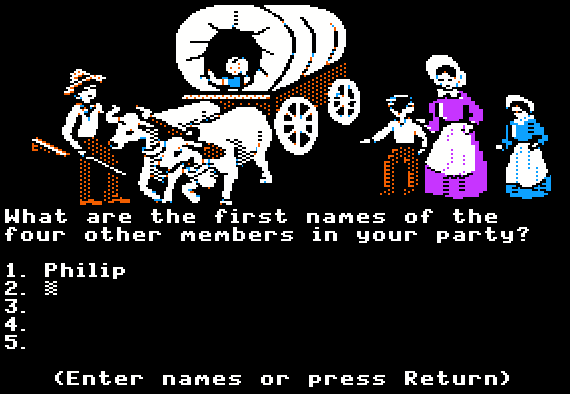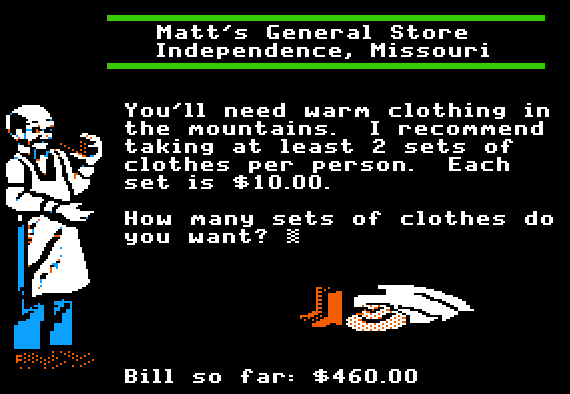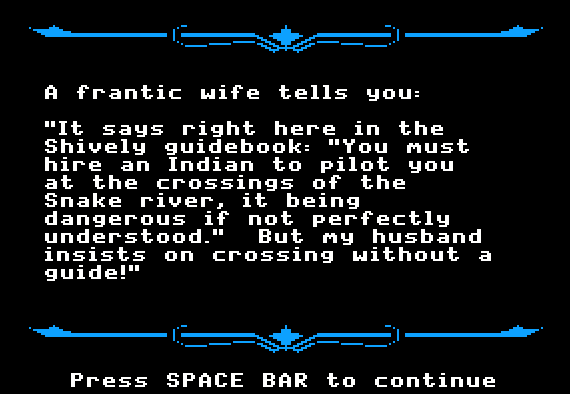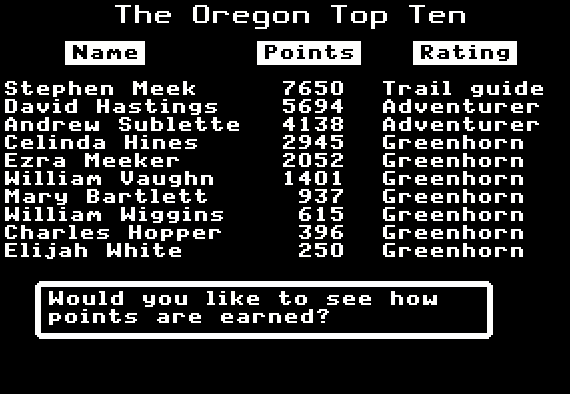Early in the 1984-85 Oregon Trail project, my second highest priority (after incorporating real geography into the product) was to include human characters in the design. The original 1971 design omitted the concept of people, and therefore you travel the entire 2000-mile route without ever meeting or interacting with another person. I wanted to change that. I brainstormed many distinct concepts for how the player might interact with human characters along the way – or at least be aware of other humans— and I sincerely hoped to include nearly all of these ideas in the finished product. But as the project progressed, I had to eliminate some of my most cherished concepts, because of limited space on the floppy disk and limited budget to design and build the product. However, I was able to incorporate several of the concepts into the design, each of which made a significant impact on the “human feel” of the 1985 product.
The most impactful of these new concepts was that each player would travel with a family. Before you can begin the journey, you must name four other people who will travel with you — typically family members or friends. Each member of your 5-person party is subject to illness and accidents. As you travel the trail, a principal goal is to keep all of these people alive and healthy. If any of them gets sick or dies, then they are mentioned by name. This was one of the most powerful features that I included in the game – and it gave many players a strong emotional investment in the outcome.

The concept of buying goods in Independence, prior to beginning the journey to Oregon, was part of the original 1971 design. But until my 1985 design, the player never interacted with a human character while making the purchases. My teammates and I decided very early in the design process that in the new game, you would enter a shop named "Matt's General Store". In addition to making the interaction more human, I saw a second advantage – Matt could provide you with helpful advice as you make your purchases.

As I did my historical research prior to designing the new game, I realized that on the Oregon Trail, people tended to congregate at key landmarks along the trail – such as forts, river crossings, and famous geologic features. These people included not only other travelers, but also Native Americans, local traders, and soldiers. Therefore, at each landmark in the game, my design allows the player to meet and talk to three different people — each of whom offers an interesting perspective on his or her experiences. Furthermore, many of these conversations provide helpful hints about how to survive the journey. (Unfortunately, due to limited disk space, we could not include pictures of these characters.)

Another new feature in my design was the pre-populated high-score list. (The 1971 game did not provide a final score, much less a high-score list.) If you make it all the way to Oregon, then you see the names of actual people who made the journey to Oregon or who served as early explorers in the region. The main purpose of this feature was to encourage replay, but it does add slightly to the human feel of the game. (Note: The actual first name of Hastings was "Lansford", not "David" – but the name had too many characters to fit into the available space!)

Thanks to the lead graphic designer, Charolyn Kapplinger, people also appear in many of the large landmark graphics, such as the South Pass image shown below. This also adds significantly to the human side of the design.

My single biggest regret regarding The Oregon Trail is that I had to abandon most of my ideas for complex, nuanced interactions with Native Americans. Several such modules were included in the design concepts that I wrote up. However, a few of the simpler ideas did make it into the finished product. For example, you are much more likely to have a successful crossing of the Snake River if you hire a local Indian to guide you — which was also the case on the real Oregon Trail.

Furthermore, among the 60 characters that appear when you talk to people at landmarks, there are several Native Americans – who cast a fascinating light on what it was like to live so near the Oregon Trail.
Of the many ideas for human interactions that I had considered including in the game, but ultimately did not, three stand out as particularly interesting.